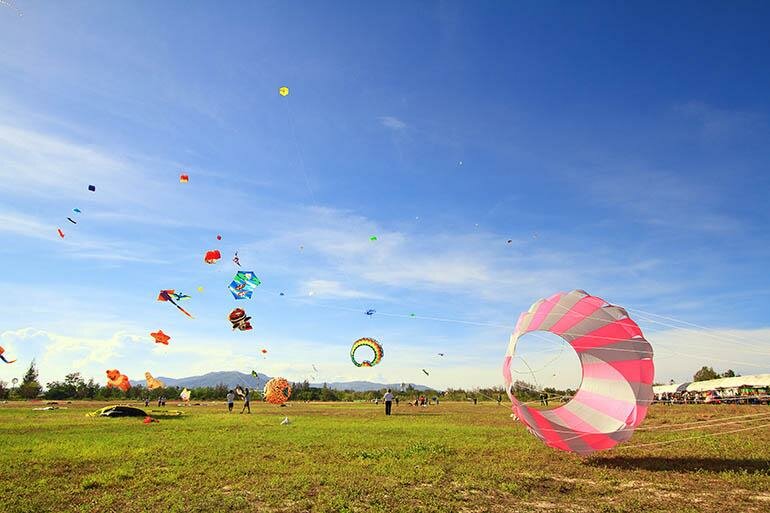Words: Steven Leonard | Photos: Various photographers | Video: Various film-makers
It’s 2013 and the world of kites is very different to what most will remember or realise. While your childhood single-line kite still exists, advances in modern materials and design mean that it is now possible to do incredible things with kites. From flying indoors, to performing mind bending acrobatic tricks, to formation flying with pinpoint precision, and much more, there's not much that a modern-day kite can't do. With such a vast range of kites out there, people of all shapes, sizes, and abilities can enjoy the thrill of flight, while having loads of fun with family and friends. What this article hopes to do is (briefly) shed light on what is out there and direct you to where to find out more about kiting and kiting in South Africa. If reading is not your thing, head straight to the video links and enjoy the show.

Single line kites
The mental image most people have of kites is of a single piece of string attached to the kite. As the number of different kites using just one line is vast, for simplicity, we will look at traditional versus modern types.
Traditional
Most cultures around the world seem to have some kiting history and they all involve a single line kite. The diamond-shape kite may be the classical, modern traditional kite, but every culture had its own design, purpose and materials.
Some kites were for art, some were for kite ‘fighting’, while others were for lifting things. The traditional kite in South Africa is known as the 'Swaeltjie', and has a strong connection to South East Asia.
Modern
While modern materials have produced more refined versions of traditional single line kites, they have also taken things to much higher levels. There are beautiful intricate and detailed works of flying art, there are impressively huge inflatable creations, and there are kites that weigh less than 20 grams for flying indoors.
Dual line kites
The classic dual line kite looks similar to a hang-glider and has two lines, allowing you to control turning left or right. Fast forward to 2013 and these things are like fighter jets capable of radical acrobatic manoeuvres that seem to defy belief.
Since the kite is always moving forward and you only control left and right turns, these tricks require that one learns a specific touch and appropriate body mechanics. The resulting tricks seem like they should not be possible at all, but can be very impressive.
If that sounds too complicated or energetic for you, the kite is equally happy to zoom around the sky with a long flowing tail, while you enjoy the outdoors and draw figures with your kite.
Quad line kites
Quad line kites use four lines to give maximum control. With a line at each corner of the kite, you have control over speed, rotation, forward, backward, and sideways flight.
Revolution
While other quad line kites exist, the most common format comes from Revolution Kites. This kite was invented 25 years ago and has been refined into a very smooth, versatile, and precise range of kites. This is practically the de facto kite for social group or team flying - the current record standing at 81 Rev pilots flying in formation.
Flying indoors, urban street style, solo tricks, crowd interaction, solo routines, social group flying, and choreographed team flying in any space or wind conditions - this kite can do it all.

Power kites
Power kites are very popular with the adrenaline junkies. These kites are designed to pull you around, usually on some kind of board or buggy. These are not so much about the flight, but more about using wind power to do something - the kite is your engine.
The most popular power kite activity in South Africa is kitesurfing, and some of the best conditions in the world can be found along our coastlines. There are also a growing number of land-based activities being undertaken, including kite buggies and land boards.
Team flying
Team or group flying involves two or more people flying their kites together, much like one would see at an air show. This is the single fastest growing activity in the kiting world right now, due to the social aspect, camaraderie, and ability for anyone to participate equally, regardless of age, gender, or ability.
This is basically a bunch of friends or family going out and enjoying themselves together with their kites. Globally, the numbers involved in this is exploding and groups of 4 to 16 people are very common.
South Africa recently gained its own team in the form of Team AeroShark. Specialising in Revolution kites, but capable of flying almost any kite, they love nothing more than to share their love of flight with others. They have appeared at various events in KwaZulu-Natal and will be flying in formation at Africa’s biggest kite festival, the Cape Town International Kite Festival.
Indoor kites
Flying indoors is another rapidly growing area of kiting. Believe it or not, you don’t need a fan to fly kites indoors. These kites are made from the lightest materials and are usually not recommended for outdoor conditions.
Over the past few years, specifically designed indoor kites have become more numerous, more accessible, and lower in cost. Some kites require more space and roof height, but you do get ones that can be flown in your living room.
If you are in Cape Town, why not pop on over to the Cape Town International Kite Festival, which is being held on 2 and 3 November 2013, to see many of these kites in action, and prepare to be blown away.
Team AeroShark
The most active kiting group in South Africa. If you are interested in flying kites and want to see what happens in South Africa, this is the one place to visit and hit the LIKE button. Alternatively, AeroShark will be at the Cape Town International Festival, so if you would like to chat to any members of the team, just ask one of the organisers to find them.
www.facebook.com/TeamAeroShark
American KiteFliers Association
A non-profit organization dedicated to sharing kite flying with the world, and a good source for more detailed information regarding what kind of kites are out there.
Kitelife Magazine
www.kitelife.com
If you’re interested in kites globally, this online publication would be a good place to visit.
http://kite.org/
Cape Town International Kite Festival
The festival happens on (and above) the lawns surrounding Zandvlei, Muizenberg (corner Axminster and The Row), on 2 and 3 November 2013. Open from 10:00 a.m. to 18:00 p.m. daily, the event offers lots of parking and easy access by train (False Bay or Muizenberg Stations). Entry is just R20 for adults and R10 (for children between 2 and 12 years). For more information, visit the website, call 021 447 9040, or get regular updates on Facebook www.facebook.com/CTKiteFest and Twitter @CTKiteFest.
www.capementalhealth.co.za











